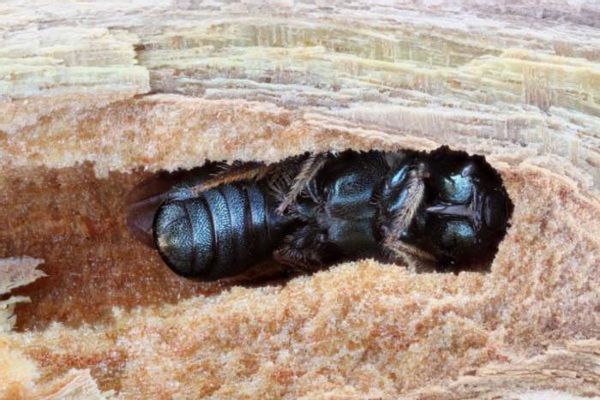
In 2016, they became the first bee species to have its entire genome published, and they are often studied by scientists because of the unique relationships between parents and their offspring. While they are otherwise solitary except when mating, spurred ceratina parents spend significant time caring for and interacting with their offspring.
Now a recent study from the peer reviewed journal Communications Biology reveals an important reason why these carpenter bee mothers spend so much time with their young: Maternal care is linked to the young bees' ability to ward off potentially deadly diseases.
It all comes down to pathogens, a term for microorganisms that can cause disease. Researchers from York University in Toronto studied the carpenter bees through four stages of their lives, starting at the larval (the equivalent of being an infant) — but denied some of those bees the maternal care they needed to survive. When comparing the genes and microbiomes of the bees that had maternal care with the ones that did not, the scientists discovered that the latter group's microbiomes "ballooned," according to a press statement. Most of the new pathogens were fungi (85 percent), but there was also plenty of bacteria (8 percent), and the consequences were clear: The infected bees displayed behavioral changes, stunted developments in their eyes and brains and even saw alterations in their gene expressions.

"There are fitness affects resulting from these fungal infections," senior author Sandra Rehan, a professor in York's Faculty of Science, said in the press statement. "We are documenting the shifts in development, the shifts in disease loads, and it is a big deal because in wild bees there is a lot less known about their disease loads. We are highlighting all of these factors for the first time."
The study emphasizes that it is contributing to an existing body of research about the role of maternal care in helping animals develop healthy immune systems. As the authors point out, there is already considerable evidence that organisms depend on their mothers in order to have the right bacteria in their bodies to fight off diseases.
"Parental care has marked impacts on immunity and microbiome, such as the transfer of core microbes essential for offspring survival as observed in earwigs, burying beetles, African clawed frogs and mice," the authors write. "The neurobiological and behavioral effects of parental care have been widely researched in social species, as it plays an essential role in the evolution of social behavior."
This research is important because we don't know much about the health of bees other than honeybees, which are technically domesticated species not native to North America. The globe is currently suffering through a pollinator crisis and we don't entirely know how to protect insects other than agriculturally-beneficial species.
"To our knowledge, our study is the first to provide metatranscriptomic insights into the relative role of maternal care on offspring development and a foundational framework for the developmental microbiome, a critical component of bee health," the authors concluded. We have much to learn about the basics of bee health, it would seem.
A July study in the Journal of Economic Entomology, analyzed as many studies as the authors could find about whether bees are adequately protected from pesticides. To their consternation, they discovered that the studies were not broadly useful because most only tested on two species of honeybee. It is unclear whether pesticide mitigation policies are effective for the more than 20,000 different species of bee worldwide.
The need to protect bee populations could not be more urgent, given that bees are pollinators who are essential to human food production. A 2022 study in the peer reviewed journal Scientific Reports found that modern honey bees have lifespans only half as long as they did back in the 1970s. The authors speculated that the declining lifespan could be due to genetic rather than environmental factors, but it remains unclear exactly why that is happening and what the implications are for other bee populations. Bees continue to be imperiled today due to everything from climate change to the overuse of dangerous pesticides.
The bee mom research is also surprising because we don't typically think of bugs being good parents, but it adds to the growing evidence that even insects are quite intelligent. A July study in the peer reviewed journal PLOS Biology transformed our understanding of bee evolution by revealing that five honeybee species and five wasp species — despite having very different evolutionary histories — both came to the same conclusions when constructing their nests. Specifically, all of the species determined that hexagons were the most architecturally sound structure for what they wished to accomplish, and all of the species used the same geometric tricks to solve various problems that arose when building their hexagon-based nests.
"I think the most interesting result is that we're finding that collective systems come up with the same solutions for the same problems, despite being separated by millions of years of evolution," Dr. Michael Smith, who teaches at Auburn University's Department of Biological Sciences, told Salon by email at the time.







